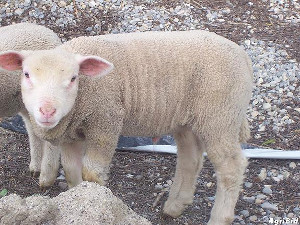Weisses Alpenschaf (CH)
Description
Large-framed white sheep breed. The woolly straight head is of medium length with ears sticking our horizontally and straight nose. Polled. Good muscles and full meaty legs. Strong extremities. The fleece is dense and tightly stapled with a fineness of F2-3 and even finer. Fertile and non seasonal. Two to three lambings are aimed at. Age at first lambing is 18 months.
General and History
The breed Swiss White Alpine developed from different local breeds (amongst others Luzein and Tavetsch). Improvement with German Merino and Ile de France for higher body weight and improved carcass. After the restructuring of breeds in 1938, the breed became more popular. Herdbook foundation 1900.
Distribution in the past and today
With approx. 50% of all herdboocks animals, the breed is the most important one in Switzerland.
Utilization
Animals are mainly kept bi part-time farmers for quality lamb production, fine wool and for pasture management.
Keeping
The White Alpine is well adapted to the production and site conditions in Switzerland. It is robust and can move safely in the mountains. 70% of the animals stay on alpine pastures during the summer, housing during wintertime lasts approx. 4 months. Approx 15% of the animals are kept on winter pastures.
Breeding aims
Opposition strength, health, freely from hereditary defects, good asaptability. Longevity with high breeding proberty average production duration: 5 years. Ability of high roughabe admission and roughage utilisation.
High-class lamb to 42kg, of LG with the battle maturity, good meat achivement (medium meaty to full-meaty). Good mountain marketability. Retention of the Asaisonalität.
Performance
Body weight: 60-130kg (m), 60-100 (w)
Withers height: 76-82cm (m), 68-74cm (w)
Fleece weight: 4.0-5.0 kg (m), 3.5-4.5kg (w)
Literature
· Schafrassen in den Alpen, Antje Feldmann, Ursula Bietzker, Dr. Christian Mendel, Gesellschaft zur Erhaltung alter und gefährdeter Haustierrassen e.V. - GEH, 2005
· Brochure «Ressources zoogénétiques de l’agriculture suisse», 20.09.2021, Office Fédéral de l'Agriculture, OFAG








